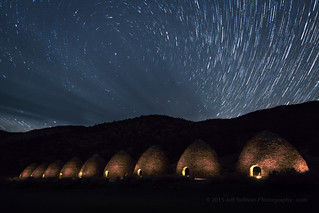 |
| Exploring a small slot canyon on a moonlit night |
Last month I bought a high end ProtoMachines LED2 light to use for light painting. It has presets for tungsten and daylight white balance, so I decided to test its ability to light objects at night with cool, warm and neutral light settings. I also wanted to get a feel for what intensities worked best. The LED2 can be used in a brightness range of 9 stops of light. Each stop represents a 2X intensity change, so its brightest setting should be 512X brighter than its dimmest one.
 |
| Illuminated landscape under moonlight |
One night offered partial moon illumination of roughly 50%, not terribly different from the conditions we'll be shooting under in our upcoming night photography and light painting workshop in the ghost town of Bodie on May 24. I illuminated the landscape from about 100 feet away from two positions 50 feet to the right and left of the camera, with the light on intensity levels 4 and 5 (on the scale of 9). I had checked the daylight and tungsten settings and used RGB values between them to have the light be fairly neutral. I also used the light to explore a short passage between eroded clay walls (image at top), with the light set to its daylight preset for a warmer effect.
 |
| Badwater Salt Flats, Death Valley |
I also went out on moonless nights, illuminating the foreground using a neutral white color close to what I expected to be using as a white balance for the rest of the photo. For the Badwater salt flats I illuminated the foreground from roughly 20 feet to each side. Due to the darkness of the sky, the sensitivity of my camera settings, and the proximity of the foreground to both the camera and the light, I used intensity levels between 1 and 2.
A point source of light can be though of as sending light in all directions in a sphere. As you get further away from the source, the sphere is much larger, so the light spreads out over a larger area and gets less bright. If you consider the geometry and math, you get the Inverse Square Law: the light intensity on the object illuminated is inversely proportional to the square of the distance.
Photographers use the Inverse Square Law when they cut illumination intensity in half by increasing the distance of the light source by 1.4X (the square root of 2). Similarly you can double the light intensity by reducing the distance to 0.7X. The ProtoMachines light makes adjustment even easier by adjusting light intensity in stops of light, increments of 2X, so if you want the light twice as bright, you just add 1.0 to the brightness setting.
 |
| Charcoal kilns at night |
While shooting these charcoal kilns I used intensities in the 3 to 4 range, but at that higher intensity I only flashed each kiln for a second or two. I kept the light on the far side of my body so it wouldn't shop up in the image, and I kept walking so I wouldn't show up in silhouette. For some reason the light takes on a slight pinkish hue here. I must have messed up when setting the color. Since I was shooting dozens of shots in a row, I couldn't review the shot while executing the shot, but I can adjust the white balance in Adobe Lightroom after the fact.
A lot of the early adopters of this type of light use it in more of a "crazy colors" mode, painting objects in a variety of shades. For this foreground texture I decided to use additive light blending, where you add two colors to make a third. I used blue and red to see if they'd blend to make purple where they overlap. I tried to send the red light in from the left side, and the blue light up the eroded depression from the right side. For simplicity I shot the red and blue in separate 30-second exposures, and blended the two images in the free StarStaX app.
 |
| Light Blending on The Racetrack playa in Death Valley National Park |
I was able on this trip to use the light on various subjects, in variety of different modes, on subjects near and far, under various types of skies and lighting conditions. I can't wait get back out and use it some more, to practice for our first
Bodie night photography workshop of the season coming up on the night of May 24.
To see other lights I've tried and carry, read my prior post:
Gearing up for 2015 With a ProtoMachines LED2 Lighthttp://activesole.blogspot.com/2015/03/protomachines-led2-bgb-light-white-balance.html





No comments:
Post a Comment